
This website collects no information. If you e-mail me, neither your e-mail address nor any other information will ever be passed on to any third party, unless required by law.
This page was last modified February 13, 2013.
I have no sponsors and do not host paid advertisements. All external links are provided freely to sites that I believe my visitors will find helpful.
Autopsy means "see for yourself". It is a special surgical operation, performed by specially-trained physicians, on a dead body. Its purpose is to learn the truth about the person's health during life, and how the person really died.
There are many advantages to getting an autopsy. Even when the law does not require it, there is always something interesting for the family to know. In doing 1000+ autopsies, I have always found something worth knowing that wasn't known during life. Giving families the explanations they want is one of the most satisfying things that I do.
At least a fifth of autopsies reveal a cause of death other than was known to clinicians. In "routine natural deaths" in England, 34% of the time the process that was believed to be the cause of death prior to autopsy was completely wrong (J. Clin. Path. 61: 124, 2006). Consistent with my own life experience, more than a quarter of autopsies reveal a major surprise other than the cause of death (Am. J. Clin. Path. 129: 102, 2008). Even in super-health-conscious Switzerland, which is gung-ho with imaging and easy biopsies, the rate of major errors during life is still 7% (Mod. Path. 25: 777, 2012). A pathologist is a physician with a specialty in the scientific study of body parts. This always includes a year or more focused on learning to do good autopsies.
Under the laws of all US states and most other nations, autopsy can be ordered by the government. A coroner is a political position, while a medical examiner is a physician, usually a pathologist. Exactly who makes the decisions, and who just gives advice, depends on the jurisdiction. Autopsies can be ordered in every state when there is suspicion of foul play. In most states, autopsy can be ordered when there is some public health concern, i.e., a mysterious disease or a worry about the quality of health care. In most states, an autopsy may be ordered if someone dies unattended by a physician (or attended for less than 24 hours), or if the attending physician is uncomfortable signing the death certificate.
When a loved one dies, a family can ask the hospital to perform an autopsy. The hospital pathologists are supposed to be independent, and often there's no affection between them and the clinicians who treated the patient. This service has traditionally been free, with the hospital absorbing the cost (which is primarily in personnel time.)
If the family prefers, a private pathologist can do the autopsy in the funeral home. It does not matter much whether the body has been embalmed first.
Whoever does the autopsy, there should not be a problem with an open-casket funeral afterwards. This is true even if the brain has been removed and the dead person is bald. The pillow will conceal the marks.
If autopsy is not required by law, the legal next-of-kin must sign an autopsy permit.
In over three decades, I have never known a family to be sorry they got an autopsy on a loved one. I have known many who refused to allow an autopsy who were very, very sorry afterwards.
Most religions allow autopsy. If the body is that of an orthodox Jew, pathologists are happy to have a rabbi present to offer suggestions. Many Muslims prefer not to autopsy. If you have a question, check with your own religious advisor.
No hospital where I have practiced has ever charged for an autopsy on a patient who was treated there. Times change, and the hospital does have an expense for pathologist time (which may have to be arranged with a pathologist's group) and technician time. I have been aware of a couple of cases in which a hospital, already concerned about possible liability, discouraged families from requesting an autopsy by telling them there was a fee. (Most recently, a visitor told me that a Louisiana hospital listed a charge of $2000 plus transportation.) The idea of a hospital charging a family for an autopsy is opposed to my training, and in any case the charge should should be modest. Please remember that some small hospitals lack autopsy facilities, so a mortuary may need to be rented, and a special technician paid perhaps $200 for the day's work. Some pathologists are paid by the case, and the hospital might pass the pathologist's reimbursement along to the family, though this seems wrong to me. At a large hospital with full-time salaried pathologists and technicians, I am surprised to hear of anyone being charged.

Here's how an autopsy is done. In this example, there are three pathologists working together.
The body has already been identified and lawful consent obtained.
The procedure is done with respect and seriousness. The prevailing mood in the autopsy room is curiosity, scientific interest, and pleasure at being able to find the truth and share it. Most pathologists choose their specialty, at least in part, because they like finding the real answers.
Many autopsy services have a sign, "This is the place where death rejoices to help those who live." Usually it is written in Latin ("Hic locus est ubi mors gaudet succurrere vitae"). Autopsy practice was largely developed in Germany, and an autopsy assistant is traditionally honored with the title "diener", which is German for "helper".
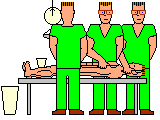
The pathologist first examines the outside of the body. A great deal can be learned in this way. Many pathologists use scalpels with rulers marked on their blades.
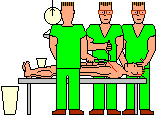
The body is opened using a Y-shaped incision from shoulders to mid-chest and down to the pubic region. If the head is to be opened, the pathologist makes a second incision across the head, joining the bony prominences just below and behind the ears. When this is sewed back up, it will be concealed by the pillow on which the dead person's head rests.
The pathologist uses a scalpel for these incisions. There is almost no bleeding, since a dead body has no blood pressure except that produced by gravity.
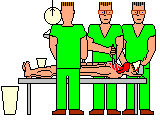
The incisions are carried down to the skull, the rib cage and breastbone, and the cavity that contains the organs of the abdomen. The scalp and the soft tissues in front of the chest are then reflected back. Again, the pathologist looks around for any abnormalities.
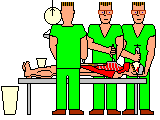
Here, one pathologist is preparing to open the skull, using a special vibrating saw that cuts bone but not soft tissue. This is an important safety feature.
Another pathologist is cutting the cartilages that join the ribs to the breastbone, in order to be able to enter the chest cavity. This can be done using a scalpel, a saw, or a special knife, depending on the pathologist's preferences and whether the cartilages have begun to turn into bone, as they often do in older folks.
The third pathologist is exploring the abdominal cavity. The first dissection in the abdomen is usually freeing up the large intestine. Some pathologists do this with a scalpel, while others use scissors.
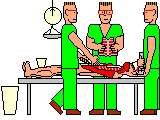
The skull vault is opened using two saw cuts, one in front, and one in back. These will not show through the scalp when it is sewed back together.
When the breastbone and attached rib cartilages are removed, they are examined. Often they are fractured during cardiopulmonary resuscitation.
Freeing up the intestine takes some time. The pathologist in this picture is cutting along the attachment using a scalpel.
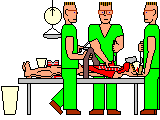
The top of the skull is removed, and the brain is very carefully cut free of its attachments from inside the skull.
The chest organs, including the heart and lungs, are inspected. Sometimes the pathologist takes blood from the heart to check for bacteria in the blood. For this, he/she uses a very large hypodermic needle and syringe. The pathologist may also find something else that will need to be sent to the microbiology lab to search for infection. Sometimes the pathologist will send blood, urine, bile, or even the fluid of the eye or samples of brain and/or liver for chemical study and to look for medicine, street drugs, alcohols, and/or poisons.
Then the pathologist must decide in what order to perform the rest of the autopsy. The choice will be based on a variety of considerations. This team will use the method of Virchow, removing organs individually. After the intestines are mobilized, they may be opened using special scissors.
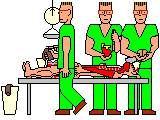
Inspecting the brain often reveals surprises. A good pathologist takes some time to do this.
The pathologist examines the heart, and generally the first step following its removal is sectioning the coronary arteries that supply the heart with blood. There is often disease here, even in people who believed their hearts were normal.
After any organ is removed, the pathologist will save a section in preservative solution. Of course, if something looks abnormal, the pathologist will probably save more. The rest of the organ goes into a biohazard bag, which is supported by a large plastic container.
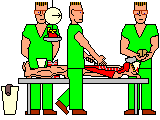
The pathologist weighs the major solid organs (heart, lungs, brain, kidneys, liver, spleen, sometimes others) on a grocer's scale. The smaller organs (thyroid, adrenals) get weighed on a chemist's triple-beam balance.
The next step in this abdominal dissection will be exploring the bile ducts and then freeing up the liver. Again, this pathologist has decided to use a scalpel.
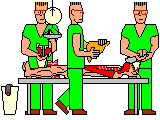
After weighing the heart, the pathologist completes the dissection. There are a variety of ways of doing this, and the choice will depend on the case. If the pathologist suspects a heart attack, a long knife may be the best choice.
The liver has been removed. The pathologist has found something important. It appears that this man had a fatty liver. It is too light, too orange, and a bit too big. Perhaps this man had been drinking heavily for a while.
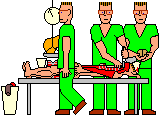
The pathologist has decided to remove the neck organs, large airways, and lungs in one piece. This requires careful dissection. The pathologist always examines the neck very carefully.
The liver in this case weighs much more than the normal 1400 gm.
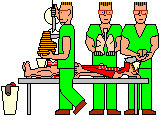
The lungs are almost never normal at autopsy. These lungs are pink, because the dead man was a non-smoker. The pathologist will inspect and feel them for areas of pneumonia and other abnormalities.
The liver is cut at intervals of about a centimeter, using a long knife. This enables the pathologist to examine its inner structure.
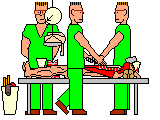
The pathologist weighs both lungs together, then each one separately. Afterwards, the lungs may get inflated with fixative.
The rest of the team is continuing with the removal of the other organs. They have decided to take the urinary system as one piece, and the digestive system down to the small intestine as another single piece. This will require careful dissection.
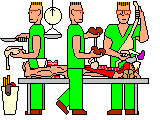
One pathologist is holding the esophagus, stomach, pancreas, duodenum, and spleen. He will open these, and may save a portion of the gastric contents to check for poison.
Another pathologist is holding the kidneys, ureters, and bladder. Sometimes these organs will be left attached to the abdominal aorta. The pathologist will open all these organs and examine them carefully.
Dissecting the lungs can be done in any of several ways. All methods reveal the surfaces of the large airways, and the great arteries of the lungs. Most pathologists use the long knife again while studying the lungs. The air spaces of the lungs will be evaluated based on their texture and appearance.
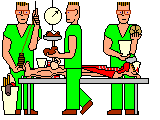
Before the autopsy is over, the brain is usually suspended in fixative for a week so that the later dissection will be clean, neat, and accurate. If no disease of the brain is suspected, the pathologist may cut it fresh.
The kidneys are weighed before they are dissected.
It is the pathologist's decision as to whether to open the small intestine and/or colon. If they appear normal on the outside, there is seldom significant pathology on the inside. I usually open them. The last pathologist is preparing the big needle and thread used to sew up the body.
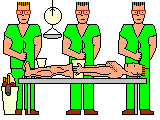
When the internal organs, have been examined, the pathologist may return all but the tiny portions that have been saved to the body cavity. Or the organs may be cremated without being returned. The appropriate laws, and the wishes of the family, are obeyed.
The breastbone and ribs are usually replaced in the body. The skull and trunk incisions are sewed shut ("baseball stitch"). The body is washed and is then ready to go to the funeral director.
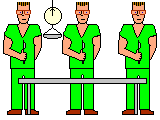
These pictures do not show all the steps of an autopsy, but will give you the general idea. Exercising my artistic license, I have omitted the pathologists' gloves and other safety equipment. And of course, in real life, there may be photographers, evidence technicians, police, hospital personnel, and others.
These pathologists will submit the tissue they saved to the histology lab tomorrow, to be made into microscopic slides. When these are ready, they will examine the sections, look at the results of any lab work, and draw their final conclusions.
The only finding in this imaginary autopsy was fatty liver. There are several ways in which heavy drinking, without any other disease, can kill a person. The pathologists will rule each of these in or out, and will probably be able to give a single answer to the police or family.
A final report is ready in a month or so. The glass slides and a few bits of tissue are kept forever, so that other pathologists can review the work. You might enjoy the animated version of this little cartoon essay. Use the "return" button of your browser to come back here.
If you like my work, help yourself. If you share, it must always be given freely, and if you use it for some good purpose, please mention that "Ed, the pathology guy", made it. If you place it on your own website, please place a link to one of my pages (your choice).
I'm also available to review the work of other pathologists, especially for attorneys. I have a policy of not taking money from the pockets of innocent people. If you need review work done, phone my assistant Gwen Dodd 816-654-7633.
To include this page in a bibliography, you may use this format: Friedlander ER (1999) Autopsy Retrieved Dec. 25, 2003 from http://www.pathguy.com/autopsy.htm
For Modern Language Association sticklers, the name of the site itself is "The Pathology Guy" and the Sponsoring Institution or Organization is Ed Friedlander MD.
The Dirt on Death -- online schools
Site includes history of forensic autopsies
Victorian Institute
JonBenet's autopsy
Celebrity Autopsies -- I will treat you or your loved one with far more respect and reverence
JonBenet's autopsy
Ronald Goldman's
Autopsy
Virtual Autopsy. This is
just now coming into its own, thanks to innovations in radiology.
It is unlikely to replace the classic pathology autopsy, but is certain
to be a useful adjunct and sometimes a suitable substitute.
Especially, 3D reconstructions in cases of trauma are helpful for
demonstration. See Radiology 240: 522, 2006. My team does virtual autopsies on
selected cases.
Virtual autopsy video. This is no substitute
for the real autopsy, though my team does these as a supplement.

|
Autopsy Videos -- "Through the Eyes of Death's Detectives" |

|
The best photos are Scott Wagner's "Color Atlas of the Autopsy" (December 2003). You can purchase this online for about $200.
How Much Do Organs Weigh?
College of American Pathologists -- Would you like to be a pathologist?
Ed Uthman MD -- tips for screenwriters
Ed Uthman MD -- autopsy tools
American Society of Clinical Pathologists -- Would you like to be a pathologist?
PathMax -- Shawn E. Cowper MD's
pathology education links
Pushin' Daisies
-- novelty site
BlueLips -- novelty site offering autopsy videos
B J Winslow -- cyberfriend who makes props
for autopsy scenes
Schools Where You Can Study Forensics
Anna Nicole Smith -- autopsy report.
If you want to know what an autopsy report looks like, click here. Or click here.
Terri Schiavo -- autopsy report is well-done
Women Are Pathologists -- dramatization to help young people understand the career
Jack the Ripper
Autopsy photo -- ruptured carcinoma of the ascending
colon
Autopsy photo -- breast cancer encasing the lung
 Ed's Home Page
Ed's Home Page
Estimating the Time of Death
Need my help?
 Ed's Students
Ed's Students
Ed's
Franciscan Notes
Ed's
Fraternity Lambda Chi Alpha
Morgagni's Autopsy Series 1761
| New visitors to www.pathguy.com reset Jan. 30, 2005: |
|
|
||
|
|
||

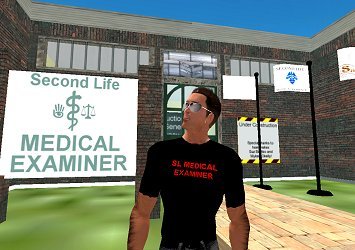
| If you have a Second Life account, please visit my teammates and me at the Medical Examiner's office. |
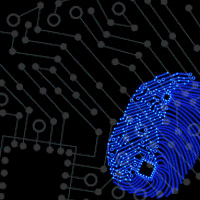
| Travis Morgan -- gym buddy, skydiver, long-term friend --
has a new site to help ordinary folks catch computer misbehavior. |